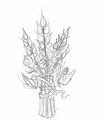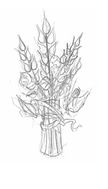The Naked Pint (51 page)
Authors: Christina Perozzi

 WILLAMETTE:
WILLAMETTE:American hop known for its spicy woody aroma.
There are many more varieties of hops out there, and knowing their different flavors is essential to becoming a quality brewer. You need to know which are primarily used for bittering purposes, for aroma, and for flavor. A hop mistake can definitely make a brew unpalatable. If you can master your hops, your homebrews have great potential. See the brewing references at the end of the chapter for more information on hops.
RecipesA
s you move ahead as a homebrewer, you will begin to truly appreci ate the skill of the master brewers. There’s nothing like doing something yourself to appreciate others who do it every day. You will taste beer in a different way, wondering about the grains, the hopping process, the strain of yeast used. You will fall in love with beer all over again, with a deeper understanding of how a beer is born.
s you move ahead as a homebrewer, you will begin to truly appreci ate the skill of the master brewers. There’s nothing like doing something yourself to appreciate others who do it every day. You will taste beer in a different way, wondering about the grains, the hopping process, the strain of yeast used. You will fall in love with beer all over again, with a deeper understanding of how a beer is born.
We asked some of our favorite brewers to supply a few of their homebrew recipes. These are people who really know what they’re doing and have been brewing for years and years, working hard to make the greatest brews. Before you try them out, you might want to brush up on your homebrew techniques with online tutorials (for example,
www.beertools.com/html/tutorial/index.shtml
) or the homebrew books mentioned later in this book.
www.beertools.com/html/tutorial/index.shtml
) or the homebrew books mentioned later in this book.
WOMAN’S WORK: FEMALE BREWERS

You may think brewing beer is a man’s job, and some women may feel that stirring the pot of mash is foreign to their sex, but oh how wrong you are! Women have always been stars of the kitchen, so it shouldn’t surprise anyone that they brew up some of the best. In fact, women were brewing beer as far back as ancient Babylon, where female brewers were considered high priestesses. Discovery of early Peruvian remains has lead archaeologists to confirm that women of that society were master brewers as well. And these female brewers were not slaves or servants but highly regarded women of the society. In medieval times, it was not unusual for the women to be the primary brewers of the household and town. Female brewers in early England and Scotland were generally known as brewsters (though this may not have been the case in certain parts of Europe, where brewster also referred to male brewers) and added beer to their list of items to make during the day. At that time, women often sat among male brewers, entrenched in the business of beer. Sometimes women inherited a brewery when they became widows. As the official Brewers Guild gained power after the 1300s, however, women were rarely allowed to be certified brewers. Men wanted this business for themselves, and this eventually took women out of the running to be professional and successful brewers.
It’s taken a while for female brewers to take their power back, and perhaps this is because beer is not marketed to the modern woman. The craft brewery world often seems to be dominated by men, but this is not true. As we write this, there are many women brewing beer in their own breweries and at home. And we’re thrilled to see women’s brewing clubs popping up all around the country. Women are embracing their history as brewsters and beer lovers, and we’re all the better for it.
To see a list of bona fide female brewers, check out the Pink Boots Society (
www.pinkbootssociety.com
), a group of women active in the business of beer.
www.pinkbootssociety.com
), a group of women active in the business of beer.

C
ulver City Home Brewing Supply (CCHBS) is our go-to for any of our homebrewing needs. Founded in 1994 and now owned by Kevin Koenig, Greg Beron, Craig Corley, and Tim Bardet, this store and homebrewing hub has been an invaluable resource for not only supplies but also advice, knowledge, and recipes. This store also happens to be the home and head-quarters of our homebrewers club, Pacific Gravity (
www.pacificgravity.com
). CCHBS now stocks over 60 different brewing grains, along with more than 20 varieties of hops.
ulver City Home Brewing Supply (CCHBS) is our go-to for any of our homebrewing needs. Founded in 1994 and now owned by Kevin Koenig, Greg Beron, Craig Corley, and Tim Bardet, this store and homebrewing hub has been an invaluable resource for not only supplies but also advice, knowledge, and recipes. This store also happens to be the home and head-quarters of our homebrewers club, Pacific Gravity (
www.pacificgravity.com
). CCHBS now stocks over 60 different brewing grains, along with more than 20 varieties of hops.
Most of the store’s recipes have names reflecting movie titles, which is appropriate because Culver City is a center of film production. Greg and Kevin have amazing know-how and are determined to teach Angele nos how to brew. We bought our first brew kit from Greg, and he showed us the ropes. The following four recipes are great for those new to homebrewing. Find a store like his in your neck of the woods and bring your recipe in. Someone there will help you get the right equipment, pick out the right ingredients, and even measure out the smallest ounce amount for you. Your local homebrew store might even teach classes and have group brewing sessions like CCHBS. Happy brewing.
Little Mac Scottish Light -/60Little Mac Scottish Light -/60 is a malty, flavorful beer that’s also low in alcohol. The -/60 stands for 60 shillings, which was the cost for a barrel of ingredients when the style was created.
SPECIALTY GRAIN BILL
MALT SOURCES
3 pounds Munich extract
1 pound light dried malt extract
1 pound light dried malt extract
HOPPING SCHEDULE
0.7 ounce Challenger (7.6%) hops, boil 60 minutes
YEAST
Wyeast 1728 Scottish Ale or White Labs WLP028 Edinburgh
FERMENTATION TEMPERATURE
65-75°F
PRIMING SUGAR
0.5 pound corn sugar dissolved in 1 cup boiling water and cooled to
room temperature
room temperature
In a small pot, heat 3 or 4 quarts of water to around 150°F (bubbles start to form on the bottom). Remove from the heat, and stir in the specialty grains. Cover and steep for 20 to 30 minutes.
Meanwhile, fill a large brewpot half full with water, and bring to a boil. When bubbles start to rise from the pot, turn off the heat and stir in both types of malt extract.
After the grains have steeped, pour the liquid and grains through a strainer directly into the main brewpot. Add some hot water to the small pot, and rinse the grains in the strainer in the hot water to extract as much flavor and sugar as you can from the grains. This is the sparging process. Add this liquid to the main pot.
Bring what is now called wort to a full, rolling boil. Watch for boilovers! Once the foaming stops, add the contents of the hop package. Maintain the boil for 60 minutes.
Meanwhile, sanitize your fermenter, strainer, airlock, and stopper.
When the boil is done, cool the pot in a sink until the sides are cool to the touch.
Pour the wort into the sanitized fermenter, add prechilled water to bring it up to 5 gallons at about 75°F, and pitch the yeast.
Ferment in the recommended temperature range for 7 to 10 days or until bubbling in the airlock has decreased to about one bubble a minute.
Bottle with dissolved priming sugar when fermentation is complete. (See Step Ten and Step Eleven on page 224.)

This Hefeweizen, American Wheat, Fruity Wheat Beer is an easy recipe for beginners but still satisfying for experienced brewers. By varying the yeast used, it can have the qualities of either a German Hefeweizen or an American Wheat Beer, and with the addition of a fruit extract, it makes a tasty Fruity Wheat Beer, too.
MALT SOURCES
6 pounds wheat extract
HOPPING SCHEDULE
0.45 ounce Perle (8.3%) hops, boil 60 minutes
YEAST
For American Wheat Beer:
Wyeast 1010 American Wheat or White
Labs WLP320 American Hefeweizen
For German-style Hefeweizen:
White Labs WLP300 Hefeweizen Ale or
Wyeast 3333 German Wheat
Wyeast 1010 American Wheat or White
Labs WLP320 American Hefeweizen
For German-style Hefeweizen:
White Labs WLP300 Hefeweizen Ale or
Wyeast 3333 German Wheat
OTHER INGREDIENTS
For Fruity Wheat Beer:
4 ounces fruit flavoring (apricot, blackberry,
cranberry, lemon, mango, raspberry); add either to secondary
fermentation or at bottling
4 ounces fruit flavoring (apricot, blackberry,
cranberry, lemon, mango, raspberry); add either to secondary
fermentation or at bottling
FERMENTATION TEMPERATURE
65-75°F
PRIMING SUGAR
0.5 pound corn sugar dissolved in 1 cup boiling water and cooled to
room temperature
room temperature
Fill a large brewpot half full with water, and heat until bubbles start to rise. Turn off the heat, and stir in the malt extract.
Add water to bring the total volume up to 3.5 to 4 gallons. This is now called wort. Bring it to a full, rolling boil. Watch for boilovers! Once the foaming stops, add the contents of the hop package. Maintain the boil for 60 minutes.
Meanwhile, sanitize your fermenter, strainer, airlock, and stopper.
When the boil is done, cool the pot in a sink until the sides are cool to the touch.
Pour the wort into the sanitized fermenter, add prechilled water to bring it up to 5 gallons at about 75°F, and pitch the yeast.
Ferment in the recommended temperature range for 7 to 10 days or until bubbling in the airlock has decreased to about one bubble a minute.
Bottle with dissolved priming sugar when fermentation is complete. (See Step Ten and Step Eleven on page 224.)
Evil Monk Belgian Pale AleEvil Monk Belgian Pale Ale is best described as an entry-level Belgian beer. It’s low in alcohol for a Belgian, and is less challenging to ferment than stronger examples.
SPECIALTY GRAIN BILL
4 ounces Caravienne malt
4 ounces Carafoam malt
4 ounces aromatic malt
4 ounces biscuit malt
4 ounces Carafoam malt
4 ounces aromatic malt
4 ounces biscuit malt
MALT SOURCES
6 pounds Pale Malt extract
HOPPING SCHEDULE
1. 0.6 ounce Perle (8.3%) hops, boil 60 minutes
2. 0.4 ounce Saaz hops, add after 45 minutes
3. 0.2 ounce Saaz hops, add at 60 minutes
2. 0.4 ounce Saaz hops, add after 45 minutes
3. 0.2 ounce Saaz hops, add at 60 minutes
YEAST
Wyeast 3522 Belgian Ardennes or White Labs WLP550 Belgian Ale or
Wyeast 3942 Belgian Wheat or other Belgian
Wyeast 3942 Belgian Wheat or other Belgian
Other books
My Favourite Wife by Tony Parsons
Black Thursday by Linda Joffe Hull
Let It Burn (A BBW Paranormal Erotic Romance) by Summers, Sierra, Summers, VJ
Toward the Sunrise by Elizabeth Camden
Missing Without A Trace by Rider, Tanya
The Goose Girl and Other Stories by Eric Linklater
Forty Stories by Anton Chekhov
Hallowe'en Party by Agatha Christie
Romance by David Mamet
Her Lover by Albert Cohen
